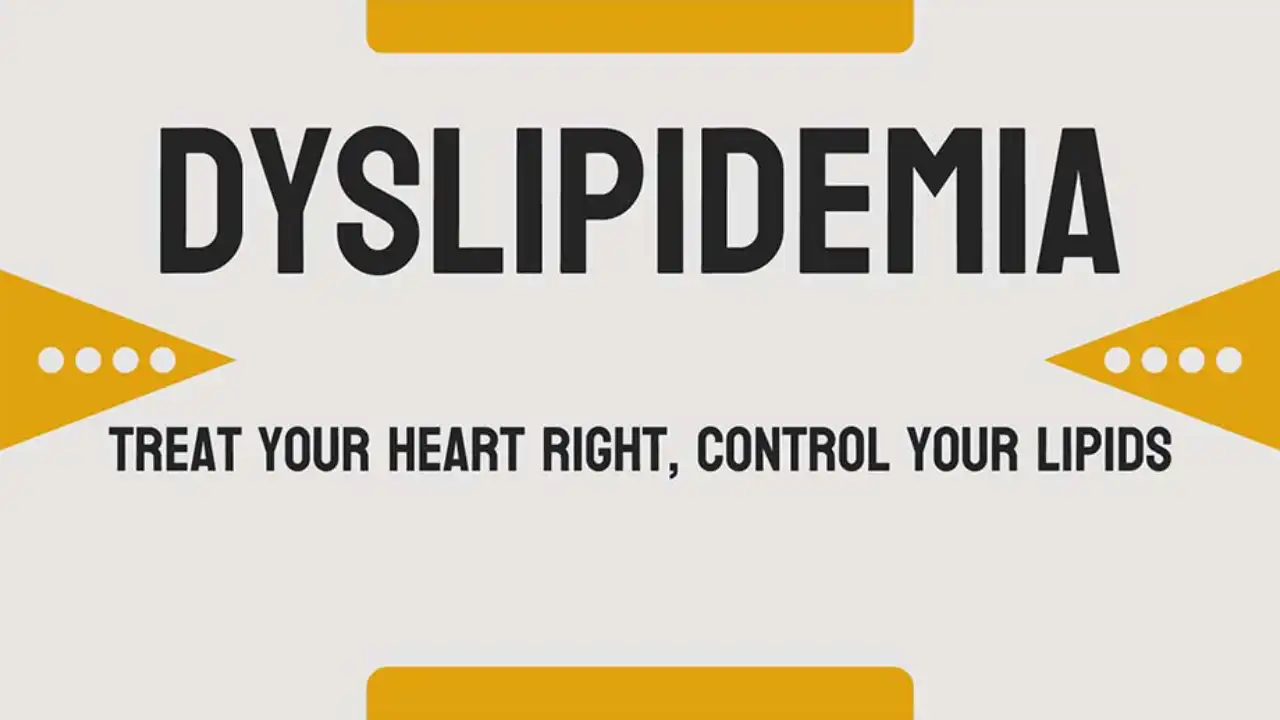ਡਿਸਲਿਪੀਡੇਮੀਆ ਖੂਨ ਵਿਚ ਚਰਬੀ ਜਾਂ ਕੋਲੇਸਟ੍ਰੋਲ ਦੇ ਅਸਧਾਰਨ ਪੱਧਰ ਨੂੰ ਦਰਸਾਉਂਦਾ ਹੈ ਅਤੇ ਦਿਲ ਦੇ ਵਿਕਾਰਾਂ ਅਤੇ ਦੌਰੇ ਲਈ ਇਕ ਮਹੱਤਵਪੂਰਣ ਜੋਖਮ ਕਾਰਕ ਹੈ। ਆਓ ਇਸ ਨੂੰ ਇਸਦੇ ਹਿੱਸਿਆਂ ਵਿੱਚ ਤੋੜ ਕੇ ਦੇਖਦੇ ਹਾਂ: ਕੋਲੇਸਟ੍ਰੋਲ ਅਤੇ ਟ੍ਰਾਈਗਲਾਈਸਰਾਈਡ।
- ਕੋਲੈਸਟ੍ਰੋਲ ਮੋਮ ਵਰਗਾ ਪਦਾਰਥ ਹੁੰਦਾ ਹੈ ਜੋ ਸਾਡੇ ਜਿਗਰ ਦੁਆਰਾ ਤਿਆਰ ਕੀਤਾ ਜਾਂਦਾ ਹੈ ਅਤੇ ਸਾਡੀ ਖੁਰਾਕ ਰਾਹੀਂ ਪ੍ਰਾਪਤ ਕੀਤਾ ਜਾਂਦਾ ਹੈ।
- ਘੱਟ ਘਣਤਾ ਵਾਲੇ ਲਿਪੋਪ੍ਰੋਟੀਨ (LDL) ਕੋਲੈਸਟ੍ਰੋਲ ਨੂੰ ਅਕਸਰ "ਮਾੜਾ" ਕਿਹਾ ਜਾਂਦਾ ਹੈ ਕਿਉਂਕਿ ਇਹ ਖੂਨ ਦੀਆਂ ਨਾੜੀਆਂ ਨੂੰ ਤੰਗ ਕਰਦਾ ਜਾਂਦਾ ਹੈ।
- ਉੱਚ ਘਣਤਾ ਵਾਲੇ ਲਿਪੋਪ੍ਰੋਟੀਨ (HDL) ਕੋਲੇਸਟ੍ਰੋਲ ਨੂੰ "ਚੰਗਾ" ਕੋਲੇਸਟ੍ਰੋਲ ਵਜੋਂ ਜਾਣਿਆ ਜਾਂਦਾ ਹੈ ਕਿਉਂਕਿ ਇਹ ਖੂਨ ਵਿਚੋਂ LDL ਕੋਲੇਸਟ੍ਰੋਲ ਨੂੰ ਹਟਾਉਣ ਵਿਚ ਸਹਾਇਤਾ ਕਰਦਾ ਹੈ।
- ਟ੍ਰਾਈਗਲਾਈਸਰਾਈਡ ਇਕ ਹੋਰ ਕਿਸਮ ਹੈ ਜੋ ਦਿਲ ਦੀ ਬਿਮਾਰੀ ਦੇ ਵਧਣ ਦੇ ਜੋਖਮ ਨਾਲ ਜੁੜੀ ਹੈ।
ਡਿਸਲਿਪੀਡੇਮੀਆ ਸੰਬੰਧੀ ਹੋਰ ਤੱਥ
- ਕਈ ਕਾਰਕ ਡਿਸਲਿਪੀਡੇਮੀਆ ਵਿੱਚ ਯੋਗਦਾਨ ਪਾਉਂਦੇ ਹਨ: ਗੈਰ-ਸਿਹਤਮੰਦ ਖੁਰਾਕ, ਸਰੀਰਕ ਗਤੀਵਿਧੀਆਂ ਦੀ ਘਾਟ, ਮੋਟਾਪਾ, ਤੰਬਾਕੂਨੋਸ਼ੀ, ਅਤੇ ਜੈਨੇਟਿਕ ਕਾਰਕ।
- ਲਿਪਿਡ ਪ੍ਰੋਫਾਈਲ ਨਾਮਕ ਇੱਕ ਖੂਨ ਦਾ ਟੈਸਟ ਕੁੱਲ ਕੋਲੇਸਟ੍ਰੋਲ, LDL, HDL ਅਤੇ ਟ੍ਰਾਈਗਲਾਈਸਰਾਈਡ ਦੇ ਪੱਧਰ ਨੂੰ ਮਾਪਦਾ ਹੈ।
- ਫਲ, ਸਬਜ਼ੀਆਂ, ਪੂਰਨ ਅਨਾਜ ਅਤੇ ਪਤਲੇ ਪ੍ਰੋਟੀਨ ਨਾਲ ਭਰਪੂਰ ਦਿਲ ਦੀ ਸਿਹਤਮੰਦ ਖੁਰਾਕ ਅਪਣਾਓ
- ਡਿਸਲਿਪੀਡੇਮੀਆ ਦੇ ਪ੍ਰਬੰਧਨ ਲਈ ਨਿਯਮਤ ਸਰੀਰਕ ਗਤੀਵਿਧੀ ਵੀ ਮਹੱਤਵਪੂਰਨ ਹੈ। ਹਰ ਹਫ਼ਤੇ ਘੱਟੋ-ਘੱਟ 150 ਮਿੰਟ ਦਰਮਿਆਨੀ ਤੀਬਰਤਾ ਵਾਲੀ ਐਰੋਬਿਕ ਕਸਰਤ, ਜਿਵੇਂ ਕਿ ਤੇਜ਼ ਤੁਰਨ ਜਾਂ ਸਾਈਕਲ ਚਲਾਉਣ ਦਾ ਟੀਚਾ ਰੱਖੋ।
- ਜਿੰਨੀ ਜਲਦੀ ਹੋ ਸਕੇ ਡਾਕਟਰਾਂ ਦੀ ਸਲਾਹ ਲੋੜੀਂਦੀ ਹੈ।
ਯਾਦ ਰੱਖੋ, ਛੋਟੀਆਂ ਤਬਦੀਲੀਆਂ ਤੁਹਾਡੀ ਸਮੁੱਚੀ ਸਿਹਤ ਅਤੇ ਤੰਦਰੁਸਤੀ ਲਈ ਵੱਡਾ ਫਰਕ ਲਿਆ ਸਕਦੀਆਂ ਹਨ!
ਹਵਾਲੇ:
- Pappan N, Rehman A. Dyslipidemia. [Updated 2022 Jul 11]. In: StatPearls [Internet]. Treasure Island (FL): StatPearls Publishing; 2023 Jan-. Available from: https://www.ncbi.nlm.nih.gov/books/NBK560891/
- Pirahanchi Y, Sinawe H, Dimri M. Biochemistry, LDL Cholesterol. [Updated 2022 Aug 8]. In: StatPearls [Internet]. Treasure Island (FL): StatPearls Publishing; 2023 Jan-. Available from: https://www.ncbi.nlm.nih.gov/books/NBK519561/

